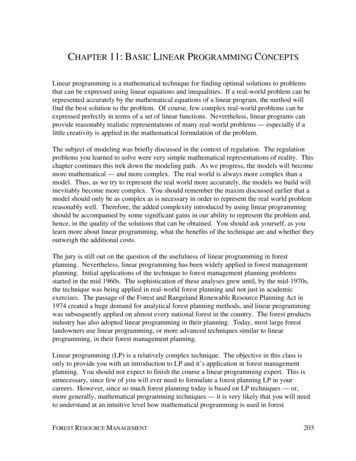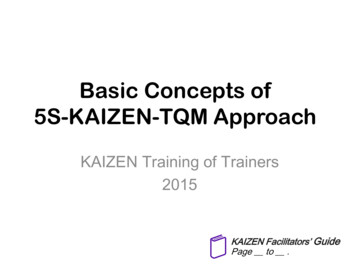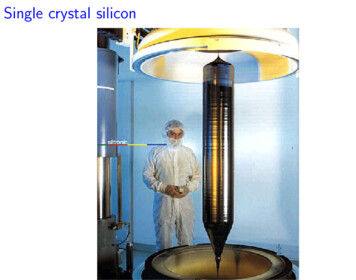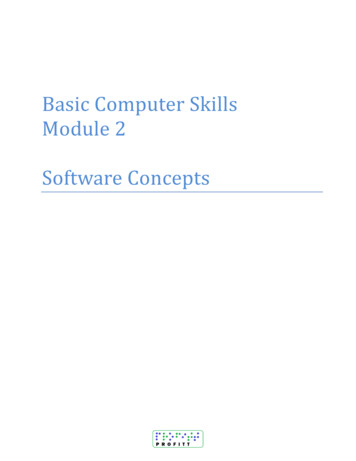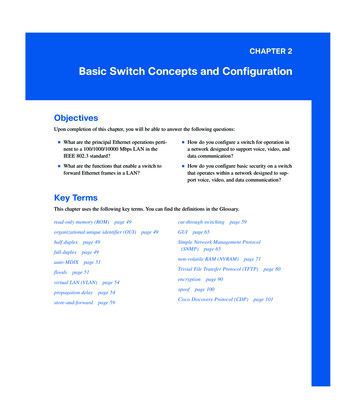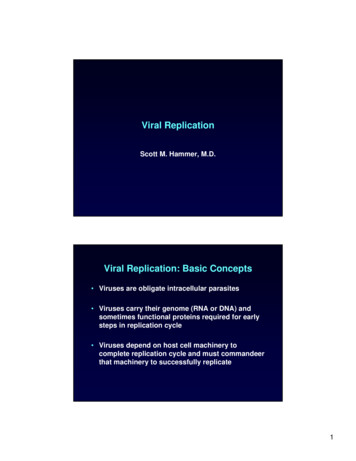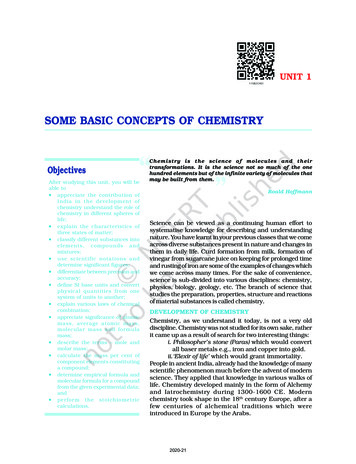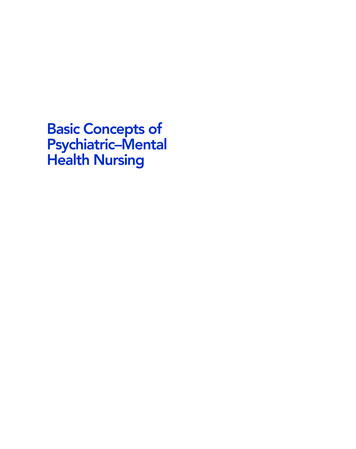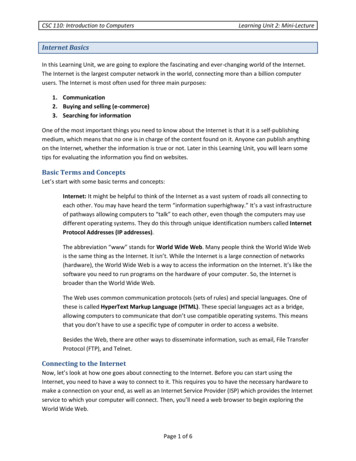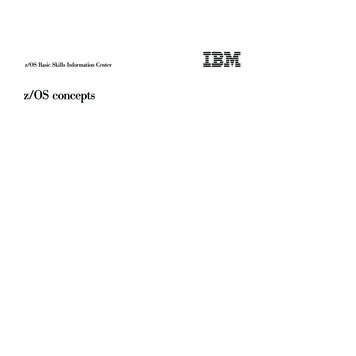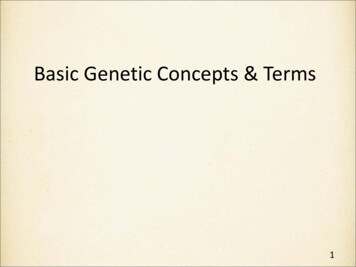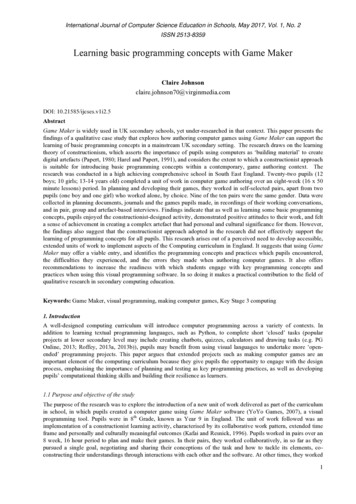
Transcription
International Journal of Computer Science Education in Schools, May 2017, Vol. 1, No. 2ISSN 2513-8359Learning basic programming concepts with Game MakerClaire Johnsonclaire.johnson70@virginmedia.comDOI: 10.21585/ijcses.v1i2.5AbstractGame Maker is widely used in UK secondary schools, yet under-researched in that context. This paper presents thefindings of a qualitative case study that explores how authoring computer games using Game Maker can support thelearning of basic programming concepts in a mainstream UK secondary setting. The research draws on the learningtheory of constructionism, which asserts the importance of pupils using computers as ‘building material’ to createdigital artefacts (Papert, 1980; Harel and Papert, 1991), and considers the extent to which a constructionist approachis suitable for introducing basic programming concepts within a contemporary, game authoring context. Theresearch was conducted in a high achieving comprehensive school in South East England. Twenty-two pupils (12boys; 10 girls; 13-14 years old) completed a unit of work in computer game authoring over an eight-week (16 x 50minute lessons) period. In planning and developing their games, they worked in self-selected pairs, apart from twopupils (one boy and one girl) who worked alone, by choice. Nine of the ten pairs were the same gender. Data werecollected in planning documents, journals and the games pupils made, in recordings of their working conversations,and in pair, group and artefact-based interviews. Findings indicate that as well as learning some basic programmingconcepts, pupils enjoyed the constructionist-designed activity, demonstrated positive attitudes to their work, and felta sense of achievement in creating a complex artefact that had personal and cultural significance for them. However,the findings also suggest that the constructionist approach adopted in the research did not effectively support thelearning of programming concepts for all pupils. This research arises out of a perceived need to develop accessible,extended units of work to implement aspects of the Computing curriculum in England. It suggests that using GameMaker may offer a viable entry, and identifies the programming concepts and practices which pupils encountered,the difficulties they experienced, and the errors they made when authoring computer games. It also offersrecommendations to increase the readiness with which students engage with key programming concepts andpractices when using this visual programming software. In so doing it makes a practical contribution to the field ofqualitative research in secondary computing education.Keywords: Game Maker, visual programming, making computer games, Key Stage 3 computing1. IntroductionA well-designed computing curriculum will introduce computer programming across a variety of contexts. Inaddition to learning textual programming languages, such as Python, to complete short ‘closed’ tasks (popularprojects at lower secondary level may include creating chatbots, quizzes, calculators and drawing tasks (e.g. PGOnline, 2013; Roffey, 2013a, 2013b)), pupils may benefit from using visual languages to undertake more ‘openended’ programming projects. This paper argues that extended projects such as making computer games are animportant element of the computing curriculum because they give pupils the opportunity to engage with the designprocess, emphasising the importance of planning and testing as key programming practices, as well as developingpupils’ computational thinking skills and building their resilience as learners.1.1 Purpose and objective of the studyThe purpose of the research was to explore the introduction of a new unit of work delivered as part of the curriculumin school, in which pupils created a computer game using Game Maker software (YoYo Games, 2007), a visualprogramming tool. Pupils were in 8th Grade, known as Year 9 in England. The unit of work followed was animplementation of a constructionist learning activity, characterised by its collaborative work pattern, extended timeframe and personally and culturally meaningful outcomes (Kafai and Resnick, 1996). Pupils worked in pairs over an8 week, 16 hour period to plan and make their games. In their pairs, they worked collaboratively, in so far as theypursued a single goal, negotiating and sharing their conceptions of the task and how to tackle its elements, coconstructing their understandings through interactions with each other and the software. At other times, they worked1
International Journal of Computer Science Education in Schools, May 2017, Vol. 1, No. 2ISSN 2513-8359cooperatively within their pairs, pursuing separate tasks, or with other members of the class, viewing each other’swork in progress, sharing their knowledge and showing others how to solve problems or achieve particular effects.The research considers whether the game authoring activity supports the learning of basic programming concepts ina mainstream secondary setting and seeks to answer the following questions:1. What programming concepts and practices do pupils encounter when authoring computer games usingGame Maker?2. What difficulties do pupils experience and what errors do they make when programming computergames using Game Maker?3. To what extent is a constructionist approach suitable for this kind of work?2. Related workGame Maker is widely used in UK secondary schools, but under-researched in that context (Johnson, 2014).Although a growing body of literature internationally refers to Game Maker, most studies provide little detail of theprogramming concepts learned when using this visual programming tool, and are rarely situated in the mainstreamsecondary phase.Research conducted in the United States reports how Game Maker has been used at tertiary level to introducecomputing concepts associated with game implementation (Chamillard, 2006; Dalal et al., 2009). In this context,Game Maker’s graphical interface was found to be useful for introducing programming concepts beforetransitioning to a textual language and resulted in improved student performance in programming assessments(Hernandez et al., 2010; Dalal et al., 2012). Other US research describes how Game Maker was used in a summercamp for pupils in Years 6-12 (n 18) (Guimaraes and Murray, 2008) and highlights the importance of allowingstudents to practice reading and modifying code in sample games before they engage in code creation themselves,noting that students are usually given the task of creating programs before they have learned how to read andunderstand them.US researchers have also investigated how Game Maker can be used to address learning objectives in other subjects,as well as supporting the learning of computer science concepts (Doran et al., 2012). This study describes theevolution of a 10 week out-of-school game authoring programme and makes the following recommendations: i)give pupils time to plan and write the pseudocode for their program segments before they implement their games; ii)include ‘guided errors’ to increase pupils’ debugging abilities (pupils responded best when they were encouraged tomake mistakes rather than avoid them) iii) clarify the sorts of games pupils can realistically create and include morestructure, targeted lessons and more development time.At primary level, Baytak and Land’s work investigates how authoring games with Game Maker can enhance thelearning of science (Baytak et al., 2008; Baytak and Land, 2010; Baytak et al., 2011). This case study researchfollows Year 5 pupils (n 10) who make games to teach younger pupils about nutrition. Findings show that theactivity was engaging for pupils and allowed them to represent their knowledge about nutrition in concrete andpersonally meaningful ways (Baytak and Land, 2010). However, there were challenges, notably with implementinggame designs with limited programming skills. While the research observes that pupils used increasing numbers ofactions in their games as the project progressed, there is no reference to learning about programming beyond this.Game Maker also features in research surrounding the development of a ‘computational thinking’ curriculum(Jenson and Droumeva, 2015) at primary level. The instructional framework followed focusses on variables,functions, mathematical operations and conditionals. Results of pre- and post-tests show that CS knowledgeimproved over the 15-hour intervention, but the authors emphasise the need to provide a structured and scaffoldedcurriculum that includes direct instruction of computational concepts in addition to self-directed learning.Seaborn et al., (2012) describe the development of a game construction curriculum to replace a traditional secondarycomputer science class. High school students (n 12) were taught elementary programming using Game Maker overa six month semester and worked in groups of 3 to create 3 computer games, alternating their roles as artist, designerand programmer for each. In addition to collecting students' overall impressions, they evaluated students' technicalcompetency and self-efficacy at the start and end of the semester. Their findings show that the curriculum had apositive, statistically significant effect on CS concept comprehension, but no detail is given about these concepts.Other Game Maker research does not investigate the learning in programming that is achieved when pupils createcomputer games. Rather, the focus is on how the software has been used to enhance particular aspects of learning,2
International Journal of Computer Science Education in Schools, May 2017, Vol. 1, No. 2ISSN 2513-8359such as creativity (Eow et al., 2010), digital literacy and multi-literacies (Sanford and Madill, 2007; Beavis andO'Mara, 2010; Beavis et al., 2012; O'Mara and Richards, 2012), multimedia design (Beavis et al., 2012), gamedesign (Redfied and Uhlig, 2012) and how the program has been used as a motivation for learning in other subjects(Fluck and Meijers, 2006; Baytak et al., 2008), or to enhance collaborative working practices and promote socialconstructivist learning environments (Madill and Sanford, 2009). There are few studies which focus on Game Makerand how it is used to introduce programming concepts in the UK secondary curriculum (Hayes and Games, 2008;Daly, 2009) and few studies of whether authoring computer games increases young people’s understanding ofcomputer science concepts (Denner et al., 2012; Seaborn et al., 2012), or what kind of knowledge students learnfrom creating games using visual programming languages (Koh et al., 2010). Moreover, there are few studies whichlook at the learning of computing concepts through game authoring within a classroom setting (Wilson et al., 2012).This paper then, addresses a gap in the literature relating to the use of Game Maker in the lower secondaryschool/middle school IT/Computing curriculum.3. Methodology3.1 Research designThe purpose of the research was to gain an understanding of what pupils learned and what difficulties theyencountered when making a computer game using Game Maker - it is therefore a qualitative enquiry. Case studywas selected as the research method since it allowed the study of an evolving situation, namely, the introduction of aunit of work in game authoring with a group of Year 9 pupils. A single case design was chosen on the basis that theclass selected is a ‘typical’ case of a wider population of Year 9 pupils. Lessons learned from typical cases areassumed to be informative about the experiences of the average [child/class] (Yin, 2009: 48).While the case study method is criticised for lacking reliability, validity and generalisability, these are not the chiefconcern of qualitative research (Merriam, 1998); rather, the focus is on understanding the particular case (Evers andWu, 2007: 201). To strengthen the reliability of the method in the face of such criticisms, Yin recommends thedevelopment of a case study database (Yin, 2009: 45) to store data and procedures followed, so that the researchcould be replicated. For the current study, a database of pupil voice recordings and interview data, transcripts,interview schedules, and the coding system used at the analysis stage was created and stored in NVivo 8 (QSRInternational, 2008). Additionally, documented research procedures, data collection guidelines and a lessonsequence were produced, which serve to strengthen the reliability of the research.A framework for the analysis of programming concepts evidenced in the games authored was constructed withreference to documents defining generic computer programming concepts appropriate for the students within thisage group (e.g. OCR, 2011; Seehorn et al., 2011; CAS, 2012; Edexcel, 2012; NAACE, 2012; Saeli et al., 2012) andis presented in Table 1.Table 1: Concepts used to frame the analysis of programming constructsProgramming conceptsDefinitionProgram interactionInput/output, event driven. Events are used as input data.Functions (actions)Actions are used to create outputs in the game.SequenceEvents and actions are sequenced in a sensible order.Conditional statementsTest/check actions are used to test conditions.LoopsThe step/alarm event or repeat action is used to create a loop.VariablesVariables (e.g. score, lives) are used to store data in the game.3
International Journal of Computer Science Education in Schools, May 2017, Vol. 1, No. 2ISSN 2513-8359Logical operatorsLogical operators (AND, OR, NOT) are used.Boolean logicBoolean logic (true, false) is used.Relational operatorsRelational operators ( , , ) are used in expressions.Mathematical operatorsMathematical operators ( , /, *, -) are used in expressions.CoordinatesCoordinates are used to specify screen position (x, y) of objects.AnglesAngles are used to specify direction of movement of objects.Negative numberNegative number is used (e.g. to define speed, position, score).RandomnessRandomness is used (e.g. to define position or number).Relative/a
Keywords: Game Maker, visual programming, making computer games, Key Stage 3 computing 1. Introduction A well-designed computing curriculum will introduce computer programming across a variety of contexts. In addition to learning textual programming languages, such as Python, to complete short ‘closed’ tasks (popular projects at lower secondary level may include creating chatbots, quizzes .
